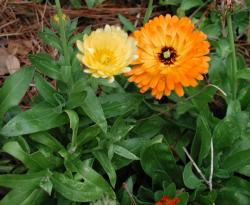
Calendula, named 2008 Herb of the Year by the International Herb Association, is among the most colorful herbs for the garden and kitchen. Known also as the poet’s marigold or pot marigold, Calendula brightens garden beds, pots, vases and culinary creations from spring to frost (or beyond) with its sunny flowers. The flowers smell like honey, slightly spicy. And woody – reminiscent of fresh rhubarb or angelica flowers – and their flavor is pleasantly mild and vegetable-sweet. Traditionally, the golden petals were used to flavor and color broths (hence the nickname “pot marigold”), butter and cheese. The dried petals even were used as a saffron substitute because they impart a rich golden color. In my own kitchen, I use Calendula in vegetable dishes, salads – particularly egg salad – custards and puddings, herb butters, baked goods, with grains and in mild-mannered soups. For best flavor, gather the flowers at their peak bloom. Gently pull the petals from the bitter center disk and discard it. The petals can be used either whole or chopped. (Note that the petals are chewy even when dried; if this bothers you, chop or puree them before you add them to a recipe.)
You can dry whole flowers, but the individual petals dry faster. I scatter them on a baking pan that I keep in a small unheated oven, then mix in a new handful of harvested petals every few days. When I have a cup or so of dried petals, I put them in a dark brown glass jar and store it away from heat and light. Having these golden petals ready to use in my kitchen and apothecary makes me feel rich. Here are a few of my favorite ways to use Calendula in the kitchen. To learn more about the health benefits of Calendula, see “Calendula: Golden Petals” at http://www.herbs-for-health.com
Calendula
Description: Hardy annual thrives in the cooler temperatures of spring and fall. Bears bright daisylike flowers, 1 to 3 inches across, on carefree 8- to 30-inch plants.
Planting: Start seed indoors 4 to 6 weeks before the average frost-free date; transplant 4-week-old seedlings outdoors. Or, sow seed directly in the garden as soon as soil can be worked in spring. Thin to 10 to 12 inches apart.
Site: Full sun; try partial shade in hottest areas. Loam soil amended with compost.
Tip: In hot climates, sow seed in late summer to early fall for bloom in fall or early next spring. Try heat-resistant cultivars such as ‘Pacific Beauty’.
